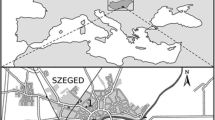Abstract
The sampling of pollen concentrations over six seasons in north London has revealed the importance of temperature in influencing the start, severity, daily and diurnal variation of Poaceae pollen seasons. Using accumulated degree days above 6°C and rainfall amount as predictors, models have been developed which account for 96% of the variation in the starting date and 91% of the variation in the severity of the Poaceae pollen season. Maximum daily temperature is an important influence on the daily pollen count although this relationship is not linear and maximum daily temperatures within the range 21.1–25°C are associated with the highest daily pollen concentrations. Likewise, when the two-hourly variation of pollen concentration is examined, temperatures within 2–4.9°C above the normal diurnal range, rather than in excess of 5.0°C, are found to be associated with the highest two-hourly concentrations. Occasional night-time maxima of pollen concentration have also been recorded and these are examined in relation to the possibility of temperature inversions, although few conclusive results have emerged.
Similar content being viewed by others
References
Davies RR, Smith LP. Forecasting the start and severity of the hayfever season. Clin Allergy 1973;4:95–108.
Dingle AN, Gatz DF. Air cleansing by convective rains. J Appl Meteorol 1966;5:160–8.
Dowding P. Wind pollination mechanisms and aerobiology. Int Rev Cytol 1987;107:421–37.
Emberlin J, Norris-Hill J. Spatial variation of pollen deposition in London. Grana 1991;30:190–5.
Emberlin J, Savage M, Jones S. Annual variations in grass pollen seasons in London 1961–1990: trends and forecast models. Clin Exp Allergy 1993;23:911–8.
Galan C, Emberlin J, Dominguez E, Bryant RH, Villamandos F. A comparative analysis of daily variations in the Gramineae pollen counts at Cordoba Spain and London, UK. Grana 1995;34:189–96.
Hill DJ, Smart IJ, Knox RB. Childhood asthma and grass pollen aerobiology in Melborne. Med J Aust 1979;i:426–9.
Hirst JM. An automatic volumetric spore trap. Ann Appl Biol 1952;39:257–65.
Liem ASN. Effect of light and temperature on the anthesis ofHolcus lantus, Festuca rubra andPoa annua. Grana 1980;19:21–9.
McDonald JE. Collection of airborne pollens by raindrops. Science 1962;135:435–7.
McDonald MS. The effects of meteorological conditions on the concentration of pollen over an estuarine area on the west coast of Ireland. Pollen Spores 1979;21:233–8.
McDonald MS. Correlation of airborne Poaceae levels with meteorological data. Grana 1980;19:53–6.
Nilsson S, Persson S. Tree pollen spectra in the Stockholm region (Sweden), 1973–1981. Grana 1981;20:179–82.
Norris-Hill J, Emberlin J. The influence of rainfall on pollen concentrations with special reference to episodes of increased concentration. Aerobiologia 1993;8:12–20.
Oke TR. (1987) Boundary Layer Climates. London, Methuen and Co.
Pasquil F. The estimation of the dispersion of wind borne material. Meteorol Mag 1962;90:33–49.
Schmidt FH. Some aspects of the transport process in the atmosphere. In: Nilsson S, editor. Scandinavian Aerobiology. Statens naturvetenskapliga forskningsrad (N.F.R.) 1973.
Spieksma FTM. Fluctuations in grass pollen counts in relation to nightly inversion and air pollution potential of the atmosphere. Int J Biometeorol 1983;27:107–16.
Spieksma FThM, den Tonkelaar JF. Four hourly fluctuations in grass pollen concentrations in relation to wet versus dry weather, and to short versus long overland advection. Int J Biometeorol 1986;30:351–8.
Steel M. Grass pollen in the atmosphere and its effect on hayfever. Weather 1983;38(5):130–9.
Subba Reddi C, Reddi NS. Relation of pollen release to pollen concentration in air. Grana 1985;24:109–13.
Summer G. Precipitation. Chichester: John Wiley and Sons, 1988.
Sutra J-P. Climat et prevention des pollinoses: La prevision statistique de la date initiale de pollinisation du bouleau en France. Climat et Sante 1992;7:53–84.
Takahashi Y, Sakaguchi M, Inouye S, Yasueda H, Shida T, Katagiri S. Airborne Poaceae pollen antigens in a grassland as studied by immunoblotting with anti-Lol p I antibody. Grana 1993;32:302–7.
Taylor J. Weather Forecasting for Agriculture and Industry. Newton Abbott, David and Charles, 1972.
Tromp SW. Biometeorology: the impact of the weather and climate on humans and their environment (animals and plants). London, Heyden, 1980.
Author information
Authors and Affiliations
Rights and permissions
About this article
Cite this article
Norris-Hill, J. The influence of ambient temperature on the abundance of Poaceae pollen. Aerobiologia 13, 91–97 (1997). https://doi.org/10.1007/BF02694424
Received:
Revised:
Accepted:
Issue Date:
DOI: https://doi.org/10.1007/BF02694424




